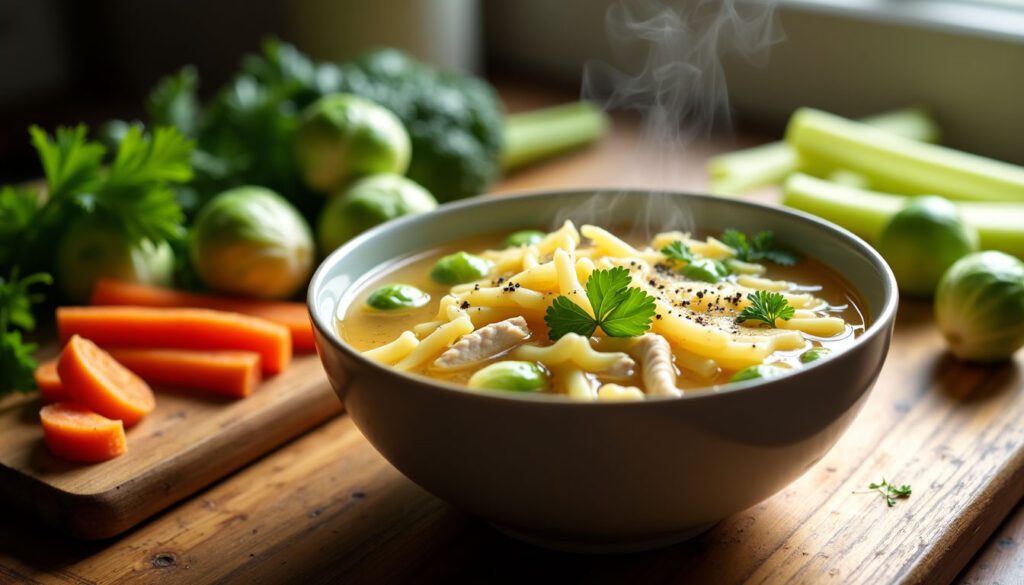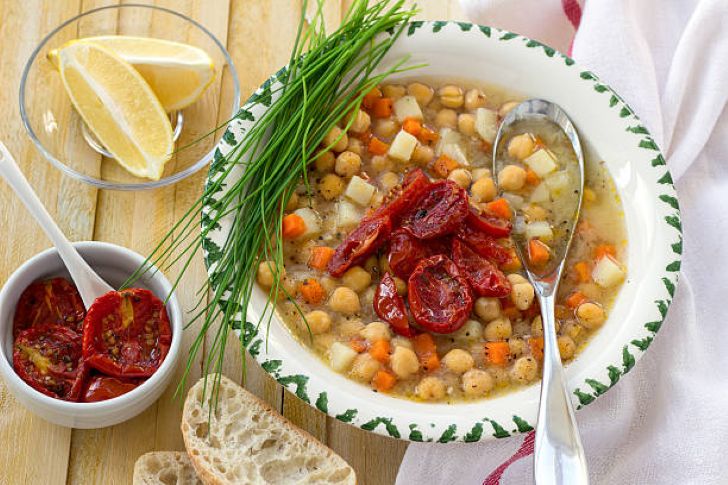How to Make Brussel Sprouts Chicken Noodle Soup
Brussel Sprouts Chicken Noodle Soup: Did you know that chicken soup contains natural anti-inflammatory properties that can actually help fight cold symptoms?

This classic comfort food gets even better when you add unexpected ingredients. While traditional chicken noodle soup already warms the soul, adding Brussels sprouts brings a delicious twist and extra nutritional punch to this beloved recipe.
Ready to transform your regular chicken noodle soup into something special? This step-by-step guide will show you exactly how to create this hearty, nutritious soup that combines tender chicken, perfectly cooked noodles, and crisp Brussels sprouts into one satisfying bowl.
Let’s start cooking!
Essential Ingredients and Equipment Guide
Success in making the perfect chicken noodle soup with Brussels sprouts starts with selecting the right ingredients and having proper equipment on hand. Let’s explore what you’ll need for this comforting dish.
Choosing the Right Chicken Cuts
For the most flavorful soup, opt for bone-in chicken pieces rather than boneless cuts. Dark meat, particularly chicken thighs, provides superior results as they remain tender during the cooking process and create a richer broth. While you can use a whole 3½-pound chicken, skinless bone-in chicken thighs are ideal for creating a flavorful yet not overly fatty broth.
Brussels Sprouts Selection Tips
When selecting Brussels sprouts, look for these key characteristics:
- Compact, firm sprouts with tightly layered leaves
- Bright green coloring without yellow leaves
- Dry stem ends without brown or moldy spots
- Small sprouts (1 to 1½ inches in diameter) for sweeter flavor
For optimal freshness, use Brussels sprouts as soon as possible after purchase, as they develop stronger flavors during storage. If you’re buying them on the stalk, inspect the spaces between sprouts and stalk for any signs of mold or dampness.
Kitchen Tools You’ll Need
A well-equipped kitchen is essential for making this soup. Your primary tool should be an 8-quart stockpot with a heavy bottom to prevent scorching during long cooking sessions Additionally, you’ll need:
- Long-handled wooden spoon for stirring
- Deep soup ladle with a hook for convenient serving
- Sharp knife for vegetable preparation
- Large cutting board
- Storage containers with tight seals for leftovers
Pro Tip: Choose a pot that’s taller than it is wide to minimize liquid evaporation during cooking. If you plan to make large batches, consider investing in glass storage containers with secure seals for proper storage and easy reheating.
Remember that having the right tools not only makes the cooking process more efficient but also contributes to better results in your final dish. Keep these tools clean and readily accessible before starting your soup preparation.
Preparing Your Base Ingredients
The foundation of an exceptional soup lies in proper ingredient preparation. Let’s transform those raw ingredients into components ready for our flavorful creation.
Cleaning and Cutting Brussels Sprouts
Start with trimming your Brussels sprouts properly. Cut off the dried-out portion at the base where the sprout was originally connected to the plant. Remove any outer leaves that appear dried, bruised, or damaged, working your way to the fresh leaves underneath. For this soup, halve the sprouts lengthwise through the core to ensure they hold together during cooking.
Making the Perfect Chicken Stock
A rich, flavorful stock forms the backbone of this soup. Here’s how to create it:
- Place chicken pieces in a large pot and cover with cold water
- Add aromatics and bring to a rapid simmer
- Lower heat for gentle bubbling
- Skim off any foam that rises to the surface
- Simmer uncovered for 3 hours
Pro Tip: Use a mix of light and dark meat with bone-in and skin-on pieces, as the bones and skin add depth to the broth while dark meat resists drying out.
Prepping Aromatics and Vegetables
The classic aromatic base for this soup requires careful preparation:
- Onions, carrots, and celery should be cut into uniform pieces
- Garlic can be added whole, halved crosswise through the middle
- Fresh herbs like thyme and bay leaves should be kept whole for easy removal
For maximum flavor development, sweat your aromatics in butter before adding the stock. This process sweetens rather than caramelizes the vegetables, creating that signature brothy flavor. Remember to season with salt throughout the cooking process, starting from the very beginning to build layers of flavor.
Important Note: When preparing vegetables, there’s no need to peel them meticulously. The peels contribute additional flavor, color, and vitamins to your stock. Just ensure they’re thoroughly washed under cold water before use.
Step-by-Step Cooking Process
Now that your ingredients are prepped, let’s dive into the cooking process that will transform them into a delicious, warming soup.
Creating the Flavorful Broth
The key to an exceptional soup lies in building layers of flavor from the ground up. Begin by bringing your pot to a rapid boil over high heat, then reduce to a gentle simmer that maintains steady, small bubbles. For maximum flavor extraction, maintain this gentle simmer for 3 hours.
Temperature Control Tip: Keep the heat low enough that you see occasional bubbles breaking the surface, not a rolling boil. This gentle approach helps extract flavors while keeping the broth clear.
Adding Ingredients in the Right Order
Follow this crucial sequence to ensure each ingredient reaches its optimal texture:
- Start with aromatics in butter until softened
- Add chicken and cold water, bringing to a boil
- Reduce heat and simmer for specified time
- Add Brussels sprouts about 10 minutes before serving
- Incorporate noodles in the final stage
Pro Tip: Skim any foam that rises to the surface during the first 30 minutes of cooking. This step ensures a cleaner-tasting, clearer broth.
Achieving Perfect Noodle Texture
The secret to perfectly cooked noodles lies in timing and temperature control. Add your noodles only when the soup is just about finished. This prevents them from becoming mushy or absorbing too much broth.
For optimal results:
- Add noodles when the broth is at a steady simmer
- Cook until they’re just halfway done
- Let the residual heat complete the cooking process
- If making ahead, consider cooking noodles separately and adding them to individual servings
Important Note: If you’re planning to freeze portions of your soup, hold off on adding the noodles until you’re ready to serve. This ensures they maintain their ideal texture even after reheating.
The Brussels sprouts should be added during the final 10 minutes of cooking. This timing allows them to become tender while maintaining their bright color and nutritional value. Watch them carefully – they should be just tender enough to pierce with a fork but still maintain their structure.
Seasoning and Flavor Enhancement
The art of seasoning transforms a simple chicken soup into a memorable dish. Let’s explore how to elevate your soup’s flavor profile through careful spice selection and strategic seasoning.
Essential Spice Combinations
Creating a well-seasoned soup requires more than just salt and pepper. Traditional chicken soup spices include:
- Base Seasonings
- Fresh thyme stems for deep flavor
- Bay leaves for earthiness
- Ground turmeric for golden hue and earthy notes
- White pepper for subtle heat
Pro Tip: Add dried herbs at the beginning of cooking to allow their flavors to fully develop and integrate into the broth.
Balancing Flavors
The secret to exceptional soup lies in achieving perfect harmony between five key flavor elements:
- Sweet: Naturally present in caramelized onions and carrots
- Salty: Enhanced through gradual seasoning throughout cooking
- Sour: Added through lemon juice or vinegar
- Bitter: Contributed by Brussels sprouts
- Umami: Developed through roasted chicken and long simmering
Remember to season at every stage of cooking – when sweating aromatics, adding stock, and incorporating vegetables. This layered approach builds depth and prevents the need for excessive salt at the end.
Adding Final Touches
The finishing touches can transform your soup from good to exceptional. A squeeze of fresh lemon juice added at the very end brightens all flavors without turning bitter. For additional depth, consider these enhancement options:
Flavor Boosters:
- A dash of fish sauce or Worcestershire sauce for extra umami
- Fresh parsley for herbal brightness
- A drizzle of extra virgin olive oil
Temperature Tip: Allow your soup to rest for 5-10 minutes before the final seasoning adjustment. Flavors become more pronounced as the temperature drops slightly, helping you avoid over-seasoning.
If your soup needs adjustment, remember these key principles: a pinch of sugar can soften harsh edges, acid brightens flat flavors, and salt enhances overall taste. For heat lovers, a small amount of cayenne pepper or fresh chili can add warmth without overwhelming the delicate balance of flavors.
Important Note: When adding Brussels sprouts, be mindful that they contribute their own natural flavors to the broth. Their slight bitterness adds complexity but should be balanced with other elements for optimal taste.
Storage and Reheating Tips
Proper food storage is crucial for maintaining both safety and flavor in your homemade soup. Let’s explore the best practices for storing and reheating this nutritious dish.
Proper Cooling and Storage Methods
The key to preserving your soup’s quality starts with proper cooling. Never place hot soup directly in the refrigerator or freezer. Instead, divide large portions into smaller containers for rapid cooling. This method prevents your soup from lingering in the temperature danger zone where bacteria can multiply.
For safe storage, follow these timeframes:
- Refrigerator (40°F or below): 3-4 days
- Freezer (0°F or below): Up to 3 months
- Seafood-based soups: Maximum 1 day in refrigerator
Safety Tip: Don’t leave soup at room temperature for more than two hours. Use shallow containers to speed up the cooling process and ensure food safety.
Reheating Without Overcooking
The challenge in reheating soup lies in maintaining the texture of each ingredient. For best results, use medium-low heat when warming your soup on the stovetop, stirring occasionally to ensure even heating. This gentle approach helps preserve the Brussels sprouts’ texture and prevents the noodles from becoming mushy.
When reheating, consider these methods:
- Stovetop: Heat over medium heat, stirring occasionally until steaming
- Microwave: Use short intervals, stirring between each to distribute heat evenly
Pro Tip: If your soup has thickened during storage, gradually add small amounts of broth or water while reheating until you reach your desired consistency.
Freezing Guidelines
For optimal freezing results, consider separating components. The broth freezes beautifully, but noodles and certain vegetables may change texture. When freezing your soup:
- Cool completely before transferring to freezer containers
- Leave approximately ½ inch of headspace for expansion
- Use freezer-safe containers or heavy-duty freezer bags
- Label containers with the date and contents
Important Note: Dairy-based soups can separate and become grainy when frozen and thawed. If your recipe includes cream, consider adding it fresh when reheating.
For Brussels sprouts specifically, they maintain better texture when frozen properly. If freezing soup with Brussels sprouts, ensure they’re not overcooked initially, as they’ll soften further during reheating.
Storage Tip: Consider freezing soup in individual portions for easier reheating. This approach not only speeds up the thawing process but also prevents waste and repeated freezing cycles.
When ready to use frozen soup, thaw it overnight in the refrigerator for best results. Avoid thawing at room temperature, as this can promote bacterial growth. If you’re in a hurry, place the frozen container in a cold water bath, changing the water every 30 minutes until thawed.
Remember to bring your soup to a proper temperature when reheating – it should be steaming hot and reach 165°F throughout. This ensures both safety and optimal flavor in your reheated dish.
Conclusion
Making chicken noodle soup with Brussels sprouts combines classic comfort with modern nutrition. This hearty dish offers both healing properties and rich flavors, while proper preparation ensures each ingredient shines in the final bowl.
Success depends on careful attention to detail – selecting quality ingredients, building flavors gradually, and maintaining proper cooking temperatures. Brussels sprouts add a unique twist that elevates this traditional soup with extra nutrients and complexity.
Remember to store your soup properly and reheat it gently to preserve the texture of each ingredient. Your homemade chicken noodle soup will taste better than any store-bought version, offering comfort and nourishment with every spoonful.
Master these techniques, and you’ll create a memorable soup that warms both body and soul. The combination of tender chicken, perfectly cooked noodles, and crisp Brussels sprouts makes this recipe a standout addition to your cooking repertoire.
You might also like: Blood Oranges – Two Salads & Some Aromatic Friands






One Comment